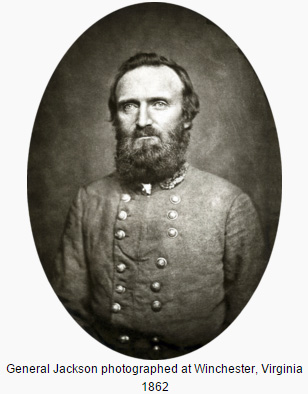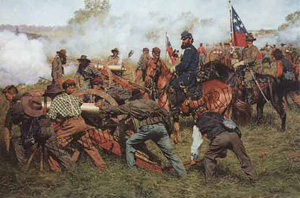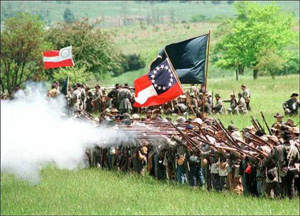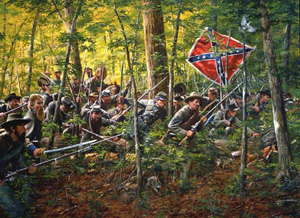
The President’s Message:
Saddle up your
favorite steed and trot to the Holiday Party Wednesday, December 14th
at 7:00 PM. Please feel free
to bring a guest. The Round Table
will supply a meat and cheese platter. However,
all members are asked to bring an appetizer, salad, entrée, casserole,
paper products, or dessert. Please
make a contribution to the raffle. The
items do not have to be Civil War related.
Any gift card is greatly
appreciated. A big “thank you” to
Harold Teltser for his generous donation of a Publix gift card.
Make sure you buy your raffle
tickets and here’s hoping you hold a winning ticket.
Robert N. Macomber, an award
winning and internationally recognized author, will be our speaker.
If you have not
already done so, please be sure to bring your dues Thank you to everyone
that has paid their annual dues. The
Round Table is very grateful to members that rounded up and also made
contributions to the Speakers Fund. Well
done!
December 14, 2016 Program:
On December 14, 2016 the CWRT will hold its Holiday Party.
Bring a dish to share.
We will once again hear from Robert Macomber.
His topic will be:
Confederate Generals in Union Blue -33 years later.
This is the fascinating story of how two famous Confederate
generals joined the US Army a third of a century after the Civil War.
It is the story of defending our country against a European foe.
November 9, 2016 Program:
Robert Krasner was the speaker. His topic was "Stonewall Jackson -
Military Genius?" Robert Krasner gave a biography and analyze Jackson's
military prowess in four parts.
1. What
made Jackson a “genius?
2. Early
Life
3. Three
campaigns
4. What
if…
 There
are many reasons why Thomas Jonathan "Stonewall" Jackson was a military
genius. Most historians
will rank him high on the scale of all time military minds.
This unique, religious, and reserve man recognized that to be
successful the South needed to use its army in unconventional ways.
Given that the North had an overwhelming advantages in manpower
and industry Jackson knew that victory lay in out-thinking the Union. There
are many reasons why Thomas Jonathan "Stonewall" Jackson was a military
genius. Most historians
will rank him high on the scale of all time military minds.
This unique, religious, and reserve man recognized that to be
successful the South needed to use its army in unconventional ways.
Given that the North had an overwhelming advantages in manpower
and industry Jackson knew that victory lay in out-thinking the Union.
First off he used speed to his advantage both on the battlefield and
racing to the next position.
This next position was often where his enemy was not located.
As an overall strategy he urged the Confederate high command to
drive into the north and cut off Washington, DC with the territory north
of that capital city. This
plan ran afoul of President Davis who was a man of little imagination.
Davis killed the plan and never raised Jackson to high command.
Two of the advances in military equipment factored into Jackson’s plans.
These were the Minié ball and light field artillery equipped with
canister rounds. These
items favored the tactical defense.
When not in a defensive position these weapons favored maneuver
so as not to find your forces executing a frontal attack.
He was so far ahead of his times that early on he had trouble convincing
Robert E. Lee of his strategy and tactics.
But, as their relationship gelled, Lee used Jackson’s tactics
even when it violated the principles of war.
This will be explained later at the battle of Chancellorsville.
Jackson was born on
January 21, 1824. By the
time he was six both of his parents had died so young Tom was an orphan.
He went to live with his half-uncle, Cummins Jackson, who owned a
grist mill in Jackson's Mill in what is today West Virginia.
Schooling was a hit and miss operation, but when he had teachers
he made the most of his opportunities.
When he did not have a teacher, he taught himself.
Jackson had an uncanny ability to focus.
He stayed with a subject until he had mastered it.
His power of concentration was unusually high.
At age 18 he was
appointed to West Point in the class of 1846.
Because of his lack of formal schooling he had trouble with
academics, but by dint of will he mastered his subjects.
Tom graduated 17th in a class of 59.
It was just in time to participate in the Mexican War.
He learned a valuable lesson in the art of maneuver.
At Cerro Gordo pass Santa Ana had dug in blocking the Americans.
It would have been folly to assault the position from the front,
so the Americans went around the position and overwhelmed the enemy from
the rear. This would be a
tactic that would serve him well in the Civil War.
In the spring of 1851
Jackson accepted a position at Virginia Military Academy.
Two years later he marries Elinor "Ellie" Junkin, but sadly she
dies in childbirth. Jackson
married again, in 1857 to Mary Anna Morrison.
While being a professor of military science he was also on the
board of a bank and a deacon of the church.
 There
were three battles that shape his Civil War career, and one of these
ended it. On July 21, 1861
35,000 Union troops under the command of
Irwin McDowell engaged P. G. T. Beauregard’s 32,000.
In spite of the larger numbers each side could only employ 18,000
in the fight. Both the
attack and the defense were poorly organized.
Beauregard did not expect the attack from the direction McDowell
chose, but the latter’s piecemeal advances were not well controlled.
Still, the North might have carried the day, the battle, and the
whole Civil War were it not for the defense around Henry House Hill.
Jackson, who believed in the tactical defense well supported by
artillery lined up just below the crest of the hill.
It was there that he made his stand and earned the nickname
“Stonewall.” McDowell could
not take that position.
After that many Union troops panicked the retreat turned into a rout. There
were three battles that shape his Civil War career, and one of these
ended it. On July 21, 1861
35,000 Union troops under the command of
Irwin McDowell engaged P. G. T. Beauregard’s 32,000.
In spite of the larger numbers each side could only employ 18,000
in the fight. Both the
attack and the defense were poorly organized.
Beauregard did not expect the attack from the direction McDowell
chose, but the latter’s piecemeal advances were not well controlled.
Still, the North might have carried the day, the battle, and the
whole Civil War were it not for the defense around Henry House Hill.
Jackson, who believed in the tactical defense well supported by
artillery lined up just below the crest of the hill.
It was there that he made his stand and earned the nickname
“Stonewall.” McDowell could
not take that position.
After that many Union troops panicked the retreat turned into a rout.
The Shenandoah Valley
was a strategic corridor in the eastern theater of operations.
For the South it was the source for agricultural goods.
For the North it wasa threat and an easy path for the South to
strike at Washington, DC.
Thus, both sides felt the need to control this area.
As an invasion route, an excellent highway, the Valley Turnpike,
ran the length of the valley.
Jackson was assigned to hold the valley while the defenses were
built up in the east to fight McClellan on the peninsular.
Jackson’s idea of strategic defense involved many instances of
tactical offense.
McClellan’s plan, which was really quite good, was to hit Richmond from
the east via the peninsular.
While this was going on McDowell was to march south to attack Richmond
from the north and have Banks capture the Shenandoah Valley.
Jackson ruined this
plan by striking Banks and another Union force under Fremont.
Evidence that Stonewall kept moving at great speed is that the
town of Winchester changed hands 25 times; once 4 times in a single day.
On May 25, 1862 Jackson struck Winchester such that Banks
retreated toward Harper’s Ferry.
This so concerned Lincoln that he called off McDowell’s march
south towards Richmond and ordered him to the Valley.
Needless to say, McClellan was not pleased.
In a series of
battles Jackson took on first Banks, then Fremont, and then Shields.
Although badly outnumbered, he was able to keep his opponents
from join each other such that he could have mass at the point of
attack. He did this by
marching his forces at great speed 646 miles in 48 days!
Shields and Fremont should have destroyed Jackson at Port
Republic on June 9th ,but Fremont only
sends a fraction of his forces to secure a key hill.
Ewell reinforces Jackson and together they defeat Fremont and
Shields. Jackson had a force
of about 17,000 with which he was able to best an opponent who had a
combined force of 60,000. Stonewall Jackson's reputation for moving his
troops so rapidly earned them the nickname "foot cavalry".
Thus ends the valley campaign.
Social class played a
large part in the make up of the officer corps of the Confederacy.
Most all of the senior leaders were “Tuckahoe” while Jackson was
“Cohee.” Tuckahoe and Cohee
were terms used during the 18th and 19th centuries to describe two
contrasting cultural groups in the Virginia and Carolina areas of the
United States. These slang
terms are now considered obscure and obsolete.
Tuckahoe refers to the low-country, slave-owning plantation
owners, with all of their economic, political, social, and English
(mostly from Northern and Western England) ethnic traits.
The Cohee were typically non-Anglican, poor, non-slave-owning,
hard-scrabble independent farmers, moving into or through the hills and
mountainous regions of Virginia and both Carolinas.
Both Tuckahoe and Cohee were often used as terms of disparagement
and derision by the opposing group.
Davis chose not to promote Jackson because he was Cohee and not
from the landed gentry like Lee.
Jackson’s cause was not helped by an unpleasant personality.
 Jackson’s final
battle was at Chancellorsville in the spring of 1863.
Once again the Federals outnumbered the Rebels.
In spite of this Lee divided his army into five groups.
He sent Jackson with 28,000 men to march around Hooker’s force of
70,000 starting on Hooker’s left and ending up on Hooker’s right flank.
In an attack, which was a total surprise, Stonewall completely
collapsed the Union flank.
The Union cause might still have been saved as they still had superior
forces and the South was badly split up.
But “Fighting Joe” Hooker had lost his nerve so Chancellorsville
was a perfect Southern victory.
However, the cost of this win was heavy for the Confederacy as
Jackson was shot by “friendly fire.”
He never recovered and died on May 10, 1863. Jackson’s final
battle was at Chancellorsville in the spring of 1863.
Once again the Federals outnumbered the Rebels.
In spite of this Lee divided his army into five groups.
He sent Jackson with 28,000 men to march around Hooker’s force of
70,000 starting on Hooker’s left and ending up on Hooker’s right flank.
In an attack, which was a total surprise, Stonewall completely
collapsed the Union flank.
The Union cause might still have been saved as they still had superior
forces and the South was badly split up.
But “Fighting Joe” Hooker had lost his nerve so Chancellorsville
was a perfect Southern victory.
However, the cost of this win was heavy for the Confederacy as
Jackson was shot by “friendly fire.”
He never recovered and died on May 10, 1863.
The story of
Stonewall Jackson has always been the source of endless “what if”
scenarios. Robert expounded
on one of these. What if
Jackson was not killed at Chancellorsville and went on to command II
Corps at Gettysburg? If it
was he who was in command during day one and stood at the base of
Cemetery Hill to be taken "if practicable."
Would he have found it practicable?
Richard Ewell did not.
Last changed: 12/02/16
Home
About News
Newsletters
Calendar
Memories
Links Join
|

